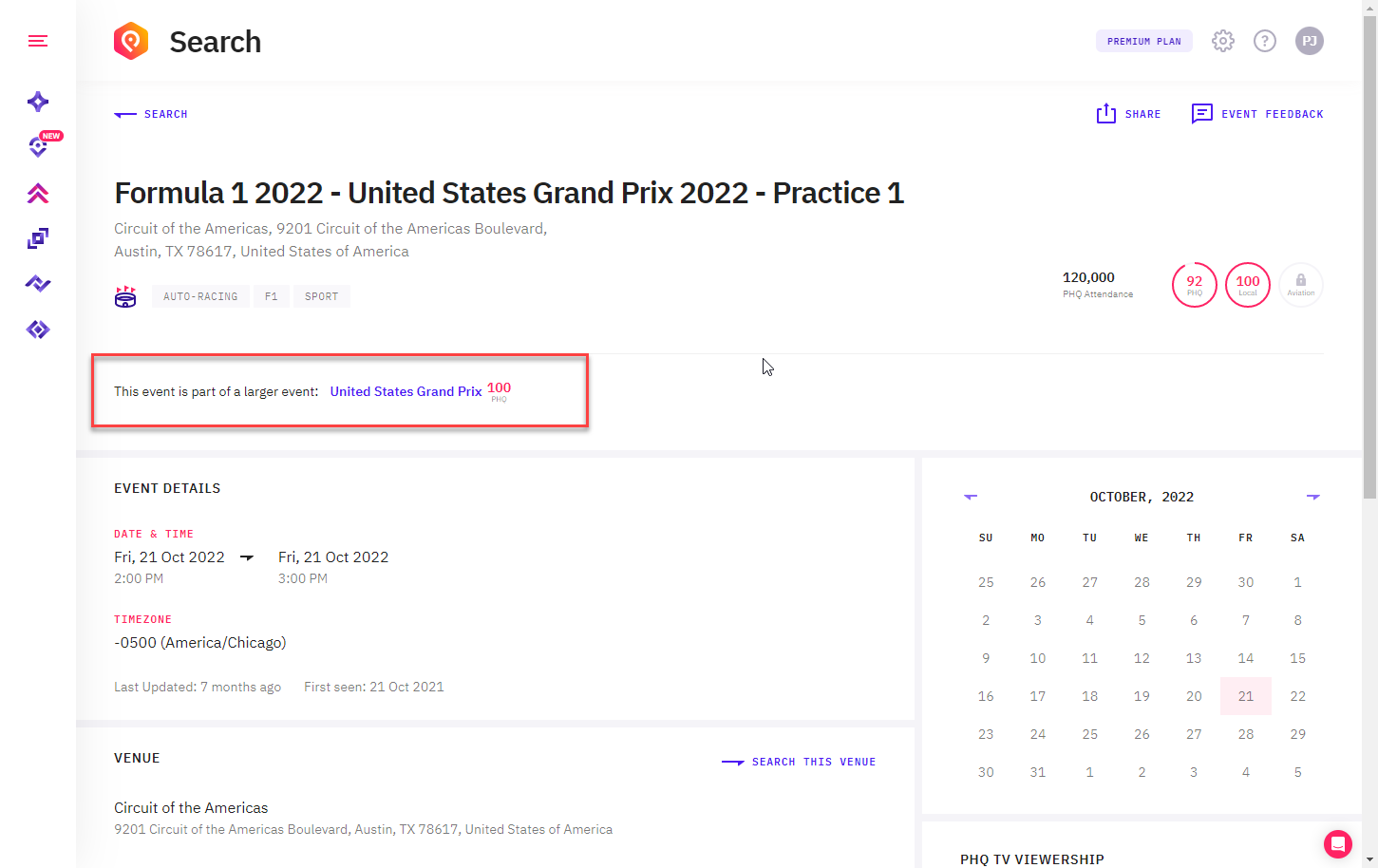Umbrella events power accurate predicted attendance outputs


What are umbrella events?
An umbrella event is when one event (a child event) belongs to another (a parent event). Umbrella events are often multi-day events, but can also be single-day events with multiple sessions if the same attendees are expected, for example, the multiple games that are part of a larger tennis tournament.
Our umbrella events feature generates families that automatically link child events with their related parent. Below is an example of an umbrella event for the US Formula 1 Grand Prix:

Similarly, the 2022 United States Grand Prix is a parent event. This event is linked to the following child events, which you can see by logging in to our web UI, Control Center:
In Control Center, we show where a child event is part of a larger parent event. This is shown as a link to the parent event on the event details page. For example, below is a Formula 1 practice session with a link to the parent event, which covers the entire 2022 Formula 1 US Grand Prix event:

This quarter, we’re excited to announce improvements to umbrella events coverage for conferences, expos, sports, and festivals! This means all events in these categories that run through our pipeline will be analyzed – and if they are part of an umbrella event set, they will automatically be linked together. Let’s explore what this update means for data accuracy, especially in regard to predicted attendance.
How umbrella events improve predicted attendance
Umbrella events improve the accuracy of our multi-day attendance in the features API by avoiding double counting of parent and child events. It's an important part of representing the relationship between events and handling the complexity of closely related events – which no other event data provider does.
PredictHQ data includes events of different duration, from events that may be less than an hour long, to events that can last multiple weeks. For our 7 attended event categories, we provide the actual or predicted attendance for events in our phq_attendance field.
The phq_attendance field works slightly differently for our different categories. For many categories, it represents the total attendance for an event over its full duration. For other categories (such as conferences), it reflects daily attendance.
For example, the phq_attendance for a high-volume event like the 2019 Tour de France is 12,000,000, which represents the total attendance for the full duration of 22 days – not the daily attendance. The daily attendance for that event is closer to 545,000 people. To avoid overcounting attendees for multi-day events, phq_attendance must be adjusted to the daily level (if it’s not already).
When using attended events in demand forecasting, a common approach is to look at the total attendance for events around a location per day. If you don’t take into account umbrella events, you could end up double-counting the attendance of the parent events and the attendance of the child events – which leads to incorrect, inflated attendance figures and can reduce the accuracy of your forecasts.
For example, the US F1 Grand Prix in 2019 is a parent event spanning 3 days with a phq_attendance of 258,000. If you were to divide the attendance of the parent event by 3 you get a daily attendance of 86,000. The actual race event running for around 3 hours on November 3rd has a phq_attendance of 120,000. Therefore, if you count the race event and the daily attendance for the parent event you’ll get 86,000 + 120,000 = 206,000, which is more than the real attendance on the 3rd. This means you will overcount the attendance.
Here are some examples of umbrella events, and examples of how they improve predicted attendance accuracy:
Automation Technology Expo East – 6 children events, 35,000 attendees. Without this umbrella family, the predicted attendance would be 130,000.
Developer Week – 7 children events, 8,000 attendees. Without this umbrella family, the predicted attendance would be 16,100.
EPC/Chemtech World Expo – 10 child events, 40,000 attendees. Without this umbrella family, the predicted attendance would be 285,376.
Design and Construction Week – 2 child events, 100,000 attendees. Without this umbrella family, the predicted attendance would be 195,000.
How to use umbrella events
See ‘Using the parent filter’ in our guide to Handling multi-day and Umbrella events. Child umbrella events have the parent_event_id field in the response. See the parent.* filter field in the events API reference. Use this filter to filter on parent and child umbrella events.
Note that if you use the features API to get aggregated attendance values, this is done automatically for you!






